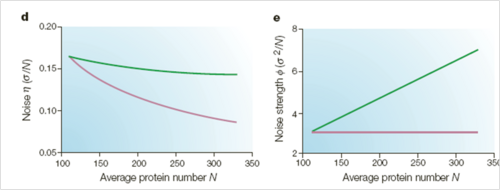Difference between revisions of "Finite Number Effect"
From GcatWiki
| Line 2: | Line 2: | ||
The most recognized source of stochasticity in cellular protein production is the finite number effect. The finite number effect states that variability, manifested in the amount of protein production, will increase as the size of the system decreases. A decrease in the size of the system refers to the protein concentration of the cell (the amount of transcriptional machinery that the cell has to work with). | The most recognized source of stochasticity in cellular protein production is the finite number effect. The finite number effect states that variability, manifested in the amount of protein production, will increase as the size of the system decreases. A decrease in the size of the system refers to the protein concentration of the cell (the amount of transcriptional machinery that the cell has to work with). | ||
=Results= | =Results= | ||
| − | + | JJ Collins et. al. Compared protein level in the cell and noise. | |
[[Image:Protein_level_effects.png| 500 px]] | [[Image:Protein_level_effects.png| 500 px]] | ||
Revision as of 20:04, 12 November 2007
What is it
The most recognized source of stochasticity in cellular protein production is the finite number effect. The finite number effect states that variability, manifested in the amount of protein production, will increase as the size of the system decreases. A decrease in the size of the system refers to the protein concentration of the cell (the amount of transcriptional machinery that the cell has to work with).
Results
JJ Collins et. al. Compared protein level in the cell and noise.
